Simplified Dynamic FEA Simulation for Post-Derailment Train-Behaviour Estimation through the Enhanced Input of Wheel–Ballast Friction Interactions
Abstract
:1. Introduction
2. Finite Element Model
2.1. Simulation Model Scope
2.2. Train Model
2.3. Track and Ballast Model
- : Friction force
- : Coefficient of friction
- : Mass
- : Acceleration due to gravity
- : Vertical normal force
- : Relative motion vector
- : Ground motion vector (velocity)
- : Train motion vector (velocity)
3. Derailment Simulation Using the Simplified FEA Model
3.1. Derailment Simulation Method and Setting of Variable Factors
3.2. Comparison of the Deceleration Effects under Different Friction Conditions
3.3. Model Validation through Comparisons with Real-World Accidents
4. Conclusions
Author Contributions
Funding
Conflicts of Interest
Appendix A
| Velocity | Max. Total Disp. (m) | Max. Lateral Disp. (m) | No. of Yawing Cars (over 45°) | Unusual Behaviour (e.g., Collision) | ||
|---|---|---|---|---|---|---|
| m/s | rad/s | |||||
| 20 | 0.05 | 1 | 161.1 | 9.6 | 0 | - |
| 2 | 114.4 | 11.1 | 0 | - | ||
| 3 | 113.3 | 11.2 | 0 | - | ||
| 4 | 110.5 | 11.4 | 0 | - | ||
| 0.1 | 1 | 116.8 | 16.3 | 0 | - | |
| 2 | 114.4 | 17.4 | 1 | - | ||
| 3 | 113.0 | 16.9 | 1 | - | ||
| 4 | 110.5 | 16.6 | 1 | - | ||
| 0.15 | 1 | 116.7 | 21.7 | 1 | - | |
| 2 | 114.7 | 22.5 | 1 | - | ||
| 3 | 113.0 | 21.8 | 1 | - | ||
| 4 | 110.7 | 20.7 | 1 | - | ||
| 0.2 | 1 | 116.6 | 26.8 | 1 | - | |
| 2 | 115.2 | 26.2 | 1 | - | ||
| 3 | 113.6 | 25.1 | 1 | First vehicle moved laterally and stopped without affecting the next car | ||
| 4 | 111.4 | 24.0 | 1 | First vehicle moved laterally and stopped after affecting the next car | ||
| 0.25 | 1 | 118.7 | 31.6 | 1 | - | |
| 2 | 115.2 | 29.7 | 1 | First vehicle moved laterally and stopped without affecting the next car | ||
| 3 | 114.2 | 27.5 | 1 | First vehicle moved laterally and stopped without affecting the next car | ||
| 4 | 112.2 | 26.4 | 1 | First vehicle moved laterally and stopped after affecting the next car | ||
| Velocity | Max. Total Disp. (m) | Max. Lateral Disp. (m) | No. of Yawing Cars (over 45°) | Unusual Behaviour (e.g., Collision) | ||
|---|---|---|---|---|---|---|
| m/s | rad/s | |||||
| 25 | 0.05 | 1 | 177.3 | 12.6 | 0 | - |
| 2 | 175.0 | 14.0 | 1 | - | ||
| 3 | 173.1 | 14.1 | 1 | - | ||
| 4 | 170.9 | 13.3 | 1 | - | ||
| 0.1 | 1 | 177.8 | 21.3 | 1 | - | |
| 2 | 175.2 | 22.1 | 2 | - | ||
| 3 | 172.8 | 21.2 | 2 | - | ||
| 4 | 170.2 | 20.2 | 2 | - | ||
| 0.15 | 1 | 179.2 | 27.1 | 1 | - | |
| 2 | 179.2 | 26.0 | 1 | First vehicle moved laterally and stopped without affecting the next car | ||
| 3 | 173.5 | 25.4 | 2 | First vehicle moved laterally and stopped after affecting the next car | ||
| 4 | 170.7 | 24.3 | 2 | First vehicle moved laterally and stopped without affecting the next car | ||
| 0.2 | 1 | 179.9 | 32.6 | 2 | Second vehicle crashed into the third after yawing | |
| 2 | 176.3 | 30.0 | 1 | First vehicle moved laterally and stopped without affecting the next car | ||
| 3 | 174.0 | 28.4 | 1 | First vehicle moved laterally and stopped without affecting the next car | ||
| 4 | 171.5 | 26.9 | 1 | First vehicle moved laterally and stopped after affecting the next car | ||
| 0.25 | 1 | 185.6 | 35.8 | 2 | ||
| 2 | 176.2 | 33.5 | 1 | First vehicle moved laterally and stopped after affecting the next car | ||
| 3 | 175.0 | 30.9 | 1 | First vehicle moved laterally and stopped without affecting the next car | ||
| 4 | 173.1 | 29.1 | 1 | First vehicle moved laterally and stopped without affecting the next car | ||
| Velocity | Max. Total Disp. (m) | Max. Lateral Disp. (m) | No. of Yawing Cars (over 45°) | Unusual Behaviour (e.g., Collision) | ||
|---|---|---|---|---|---|---|
| m/s | rad/s | |||||
| 30 | 0.05 | 1 | 250.6 | 15.3 | 0 | - |
| 2 | 248.5 | 18 | 0 | - | ||
| 3 | 245.6 | 17.9 | 2 | - | ||
| 4 | 243.5 | 16.4 | 3 | - | ||
| 0.1 | 1 | 251.3 | 21.2 | 0 | - | |
| 2 | 251.7 | 24.2 | 1 | - | ||
| 3 | 246.5 | 24.2 | 3 | - | ||
| 4 | 242.7 | 23.1 | 3 | - | ||
| 0.15 | 1 | 254.1 | 31 | 1 | Second vehicle crashed into the third after yawing | |
| 2 | 248.9 | 30.6 | 1 | - | ||
| 3 | 246.7 | 27.4 | 3 | - | ||
| 4 | 243.3 | 26.6 | 3 | - | ||
| 0.2 | 1 | 258 | 36 | 2 | Second vehicle crashed into the third after yawing | |
| 2 | 249.9 | 29.1 | 1 | - | ||
| 3 | 248 | 28.2 | 1 | First vehicle separated from the set before affecting the rest | ||
| 4 | 244.2 | 29.6 | 3 | - | ||
| 0.25 | 1 | 261.3 | 37.8 | 2 | Second vehicle crashed into the third after yawing | |
| 2 | 251.2 | 35.5 | 2 | Second vehicle crashed into the third after yawing | ||
| 3 | 247.1 | 34.2 | 3 | - | ||
| 4 | 247.2 | 31.7 | 1 | First vehicle separated from the set before affecting the rest | ||
| Velocity | Max. Total Disp. (m) | Max. Lateral Disp. (m) | No. of Yawing Cars (over 45°) | Unusual Behaviour (e.g., Collision) | ||
|---|---|---|---|---|---|---|
| m/s | rad/s | |||||
| 35 | 0.05 | 1 | 338.4 | 16.7 | 0 | - |
| 2 | 335.4 | 16.2 | 2 | First and second vehicles yawed without crushing the following cars | ||
| 3 | 332.3 | 19.9 | 3 | First and second vehicles yawed without crushing the following cars | ||
| 4 | 328.6 | 20.6 | 4 | First and second vehicles yawed without crushing the following cars | ||
| 0.1 | 1 | 339.6 | 21.2 | 1 | Second vehicle was yawing greater than the first owing to the stopping of the first | |
| 2 | 336.3 | 19.1 | 2 | First and second vehicles yawed without crushing the following cars | ||
| 3 | 332.2 | 19.8 | 3 | First and second vehicles yawed without crushing the following cars | ||
| 4 | 327.2 | 21.1 | 4 | First and second vehicles yawed without crushing the following cars | ||
| 0.15 | 1 | 342.8 | 24.1 | 2 | Second vehicle crashed into the third after yawing | |
| 2 | 336.4 | 30.6 | 2 | First and second vehicles yawed without crushing the following cars | ||
| 3 | 334.0 | 27.7 | 2 | First vehicle separated from the set before affecting the rest | ||
| 4 | 328.8 | 25.2 | 4 | First and second vehicles yawed without crushing the following cars | ||
| 0.2 | 1 | 348.7 | 33.0 | 3 | Second vehicle crashed into the third after yawing | |
| 2 | 337.8 | 33.1 | 3 | Second vehicle crashed into the third after yawing | ||
| 3 | 333.9 | 24.9 | 3 | First and second vehicles yawed without crushing the following cars | ||
| 4 | 333.6 | 28.9 | 1 | First vehicle separated from the set before affecting the rest | ||
| 0.25 | 1 | 347.7 | 37.2 | 3 | Second vehicle crashed into the third after yawing | |
| 2 | 339.1 | 35.1 | 3 | Second vehicle crashed into the third after yawing | ||
| 3 | 333.3 | 39.3 | 3 | Second vehicle crashed into the third after yawing | ||
| 4 | 329.8 | 31.4 | 3 | First vehicle separated from the set before affecting the rest | ||
| Velocity | Max. Total Disp. (m) | Max. Lateral Disp. (m) | No. of Yawing Cars (over 45°) | Unusual Behaviour (e.g., Collision) | ||
|---|---|---|---|---|---|---|
| m/s | rad/s | |||||
| 40 | 0.05 | 1 | 444.2 | 22.0 | 2 | Second vehicle crashed into the third after yawing |
| 2 | 435.4 | 22.0 | 3 | Second vehicle crashed into the third and fourth after yawing | ||
| 3 | 430.7 | 22.2 | 4 | Second vehicle crashed into the third after yawing | ||
| 4 | 425.8 | 20.8 | 4 | First and second vehicles yawed without crashing into the other cars | ||
| 0.1 | 1 | 441.4 | 21.9 | 2 | Second vehicle crashed into the third after yawing | |
| 2 | 435.5 | 29.5 | 3 | Second vehicle crashed into the third after yawing | ||
| 3 | 431.3 | 26.3 | 3 | Second vehicle crashed into the third and fourth after yawing | ||
| 4 | 427.8 | 25.4 | 4 | Second vehicle crashed into the third and fourth after yawing | ||
| 0.15 | 1 | 446.6 | 26.0 | 3 | Second vehicle crashed into the third and fourth after yawing | |
| 2 | 436.9 | 33.5 | 4 | Second vehicle crashed into the third and fourth after yawing | ||
| 3 | 432.4 | 31.7 | 4 | First vehicle separated from the set before affecting the rest | ||
| 4 | 428.8 | 29.8 | 4 | First vehicle crashed into the third after yawing and stopped | ||
| 0.2 | 1 | 448.0 | 38.6 | 4 | Second vehicle crashed into the third and fourth after yawing | |
| 2 | 441.4 | 37.4 | 5 | Second vehicle crashed into the third and fourth after yawing | ||
| 3 | 432.0 | 34.3 | 5 | Second vehicle crashed into the third and fourth after yawing | ||
| 4 | 426.1 | 33.7 | 5 | First vehicle separated from the set before affecting the rest | ||
| 0.25 | 1 | 449.8 | 40.7 | 5 | Second vehicle crashed into the third and fourth after yawing | |
| 2 | 442.0 | 38.3 | 5 | Second vehicle crashed into the third and fourth after yawing | ||
| 3 | 432.3 | 36.9 | 5 | Second vehicle crashed into the third and fourth after yawing | ||
| 4 | 426.2 | 36.1 | 5 | Second vehicle crashed into the third and fourth after yawing | ||
References
- Aircraft and Railway Accident Investigation Commission. Japan Railway Accident Investigation Report—RA2007-3-1; Aircraft and Railway Accident Investigation Commission: Tokyo, Japan, 2007.
- National Transportation Safety Board. Railroad Accident Report—NTSB/RAR-16/02, PB2016-103218; National Transportation Safety Board: Washington, DC, USA, 2016.
- Transportation Safety Board of Canada. Railway Investigation Report—R12T0038; Transportation Safety Board of Canada: Gatineau, QC, Canada, 2013. [Google Scholar]
- Rail Accident Investigation Branch. Rail Accident Report—Derailment at Grayrigg 23 February 2007; Rail Accident Investigation Branch, Department for Transport: Derby, UK, 2011.
- Coppens, A.J.; Wong, J.D.E.; Birk, A.M.; Transportation Development Centre (Canada); W.R. Davis Engineering Ltd.; A.M. Birk Engineering, Canada; Transport Dangerous Goods Directorate. Development of a Derailment Accident Computer Simulation Model; Transport Canada Publication; W.R. Davis: Ottawa, ON, Canada, 1988. [Google Scholar]
- Birk, A.M.; Anderson, R.J.; Coppens, A.J. A computer simulation of a derailment accident: Part I-Model basis. J. Hazard. Mater. 1990, 25, 121–147. [Google Scholar] [CrossRef]
- Birk, A.M.; Anderson, R.J.; Coppens, A.J. A computer simulation of a derailment accident Part II-Sample simulation. J. Hazard. Mater. 1990, 25, 149–165. [Google Scholar] [CrossRef]
- Paetsch, C.R.; Perlman, A.B.; Jeong, D.Y. Dynamic Simulation of Train Derailments. In Proceedings of the ASME International Mechanical Engineering Congress and Exposition, Chicago, IL, USA, 5–10 November 2006; pp. 105–114. [Google Scholar]
- Zhu, X.; Lu, X.-Z.; Cheng, Q.-L.; Li, Y. Simulation of the running attitude of a train after derailment. Int. J. Crashworthiness 2020, 25, 213–219. [Google Scholar] [CrossRef]
- Bae, H.-U.; Yun, K.-M.; Moon, J.; Lim, N.-H. Impact force evaluation of the derailment containment wall for high-speed train through a collision simulation. Adv. Civ. Eng. 2018, 2018, 2626905. [Google Scholar] [CrossRef]
- Bae, H.-U.; Yun, K.-M.; Lim, N.-H. Containment capacity and estimation of crashworthiness of derailment containment walls against high-speed Trains. Proc. Inst. Mech. Eng. Part F J. Rail Rapid Transit 2018, 232, 680–696. [Google Scholar] [CrossRef]
- Zhou, X.; Jing, L.; Ma, X. Dynamic finite element simulation of wheel–rail contact response for the straight track case. Adv. Struct. Eng. 2021, 24, 856–869. [Google Scholar] [CrossRef]
- Wu, X.; Chi, M.; Gao, H.; Ke, X.; Zeng, J.; Wu, P.; Zhu, M. Post-derailment dynamic behavior of railway vehicles travelling on a railway bridge during an earthquake. Proc. Inst. Mech. Eng. Part F J. Rail Rapid Transit 2016, 230, 418–439. [Google Scholar] [CrossRef]
- Kirkpatrick, S.W.; Lin, C.-Y.; Iannacone, L.; Gharzouzi, P.; Treichel, T.; Barkan, C.P.L.; Gardoni, P. Derailment analysis for prediction of damage and probability of release for novel railroad tank car designs. Transp. Res. Rec. J. Transp. Res. Board 2022, 03611981221137589. [Google Scholar] [CrossRef]
- Song, I.-H.; Kim, J.-W.; Koo, J.-S.; Lim, N.-H. Modeling and simulation of collision-causing derailment to design the derailment containment provision using a simplified vehicle model. Appl. Sci. 2019, 10, 118. [Google Scholar] [CrossRef]
- Song, I.-H.; Koo, J.-S.; Shim, J.-S.; Bae, H.-U.; Lim, N.-H. Theoretical prediction of impact force acting on derailment containment provisions (DCPs). Appl. Sci. 2023, 13, 3899. [Google Scholar] [CrossRef]
- Wu, X.; Chi, M.; Gao, H.; Zhang, D.; Zeng, J.; Wu, P.; Zhu, M. The study of post-derailment measures to limit the extent of a derailment. Proc. Inst. Mech. Eng. Part F J. Rail Rapid Transit 2016, 230, 64–76. [Google Scholar] [CrossRef]
- Lim, N.-H.; Kim, K.-J.; Bae, H.-U.; Kim, S. DEM analysis of track ballast for track ballast–wheel interaction simulation. Appl. Sci. 2020, 10, 2717. [Google Scholar] [CrossRef]
- Korea Railroad Train Information, High-Speed Train, ‘KTX-Eum’. Available online: https://info.korail.com/infoeng/contents.do?key=1605 (accessed on 14 April 2023).
- Korea National Railway Train Specification ‘HEMU430X’. Available online: http://www.kric.go.kr/jsp/board/portal/sub02/rcd/railDogam5Detail.jsp?p_id=A030503001&seq=77 (accessed on 14 April 2023).
- Korea Meteorological Administration Annual Average Temperature. Available online: http://www.climate.go.kr/home/05_prediction_new/predict04_01.php (accessed on 14 April 2023).
- Olofsson, U. Adhesion and Friction Modification. In Wheel–Rail Interface Handbook; Lewis, R., Olofsson, U., Eds.; Woodhead Publishing: Cambridge, UK, 2009; pp. 510–527. ISBN 978-1-84569-412-8. [Google Scholar]
- Zhu, Y. Adhesion in the Wheel-Rail Contact. Comprehensive Summary. Ph.D. Thesis, KTH Royal Institute of Technology, Stockholm, Switizerland, 2013. [Google Scholar]
- Vollebregt, E.; Six, K.; Polach, O. Challenges and progress in the understanding and modelling of the wheel–rail creep forces. Veh. Syst. Dyn. 2021, 59, 1026–1068. [Google Scholar] [CrossRef]
- Aviation and Railway Accident Investigation Board. Railway Accident Investigation Report—ARAIB/R 2018-1; Aviation and Railway Accident Investigation Board: Sejong-si, Republic of Korea, 2018.
- Ling, L.; Dhanasekar, M.; Thambiratnam, D.P.; Sun, Y.Q. Lateral impact derailment mechanisms, simulation and analysis. Int. J. Impact Eng. 2016, 94, 36–49. [Google Scholar] [CrossRef]
- Kim, J.; Song, I.; Koo, J. Prediction of theoretical derailments caused by cross-winds with frequency. Appl. Sci. 2021, 11, 2947. [Google Scholar] [CrossRef]
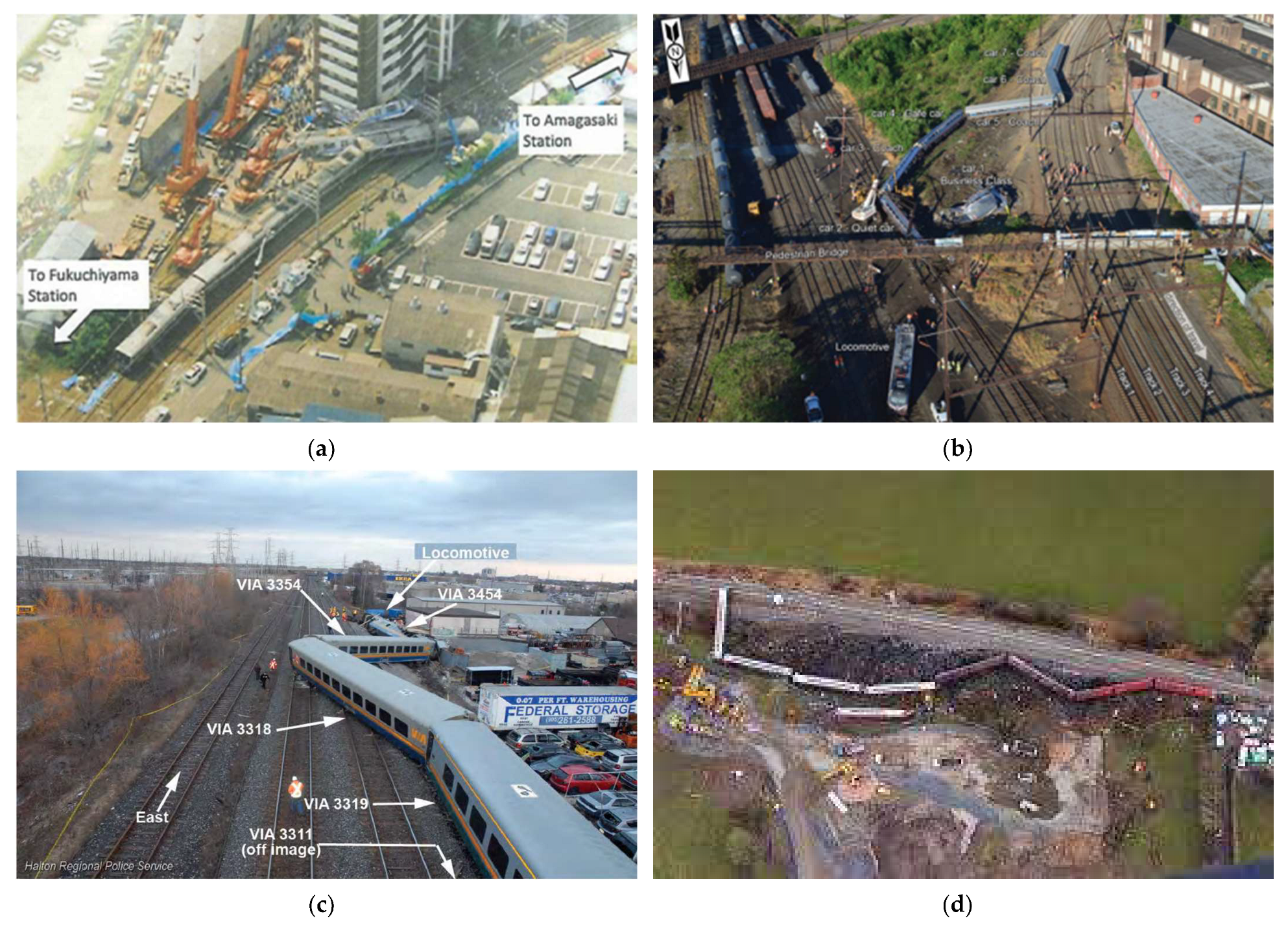
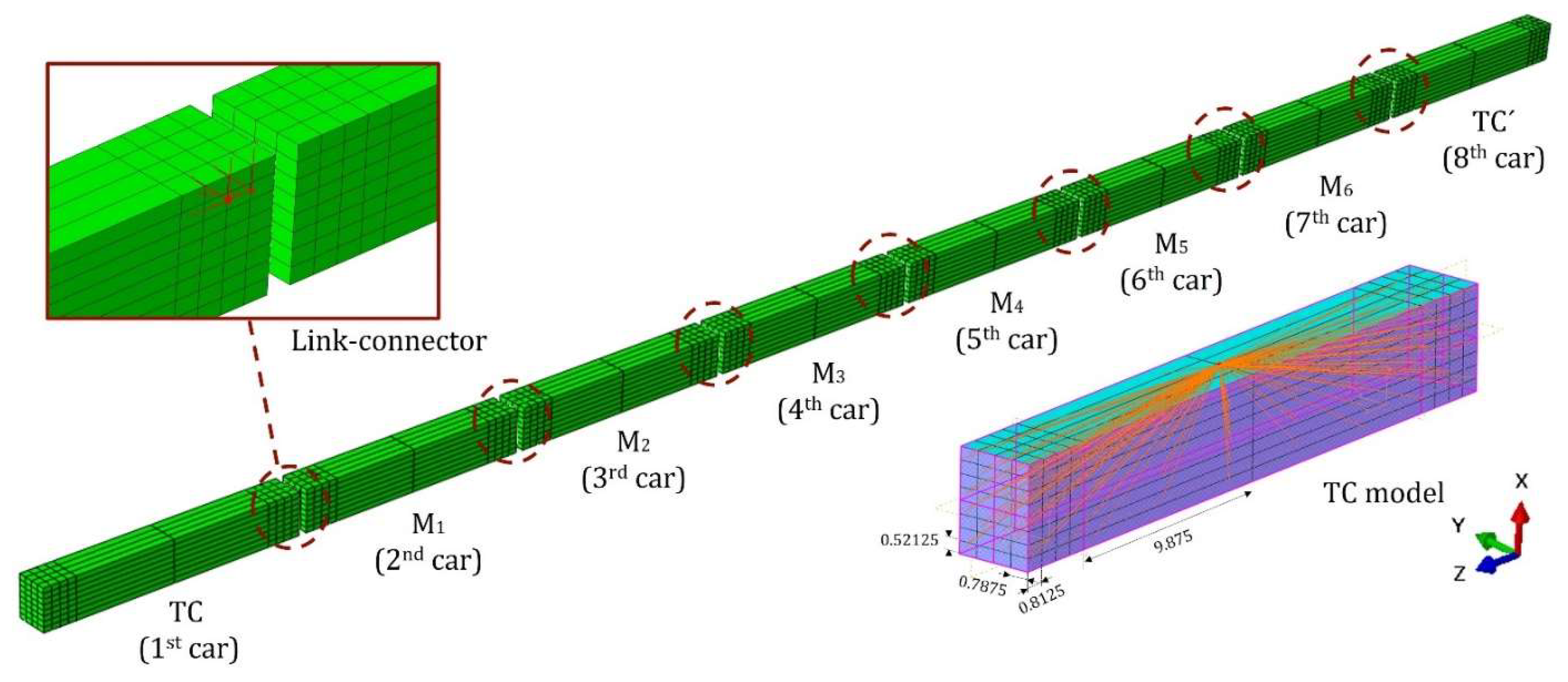

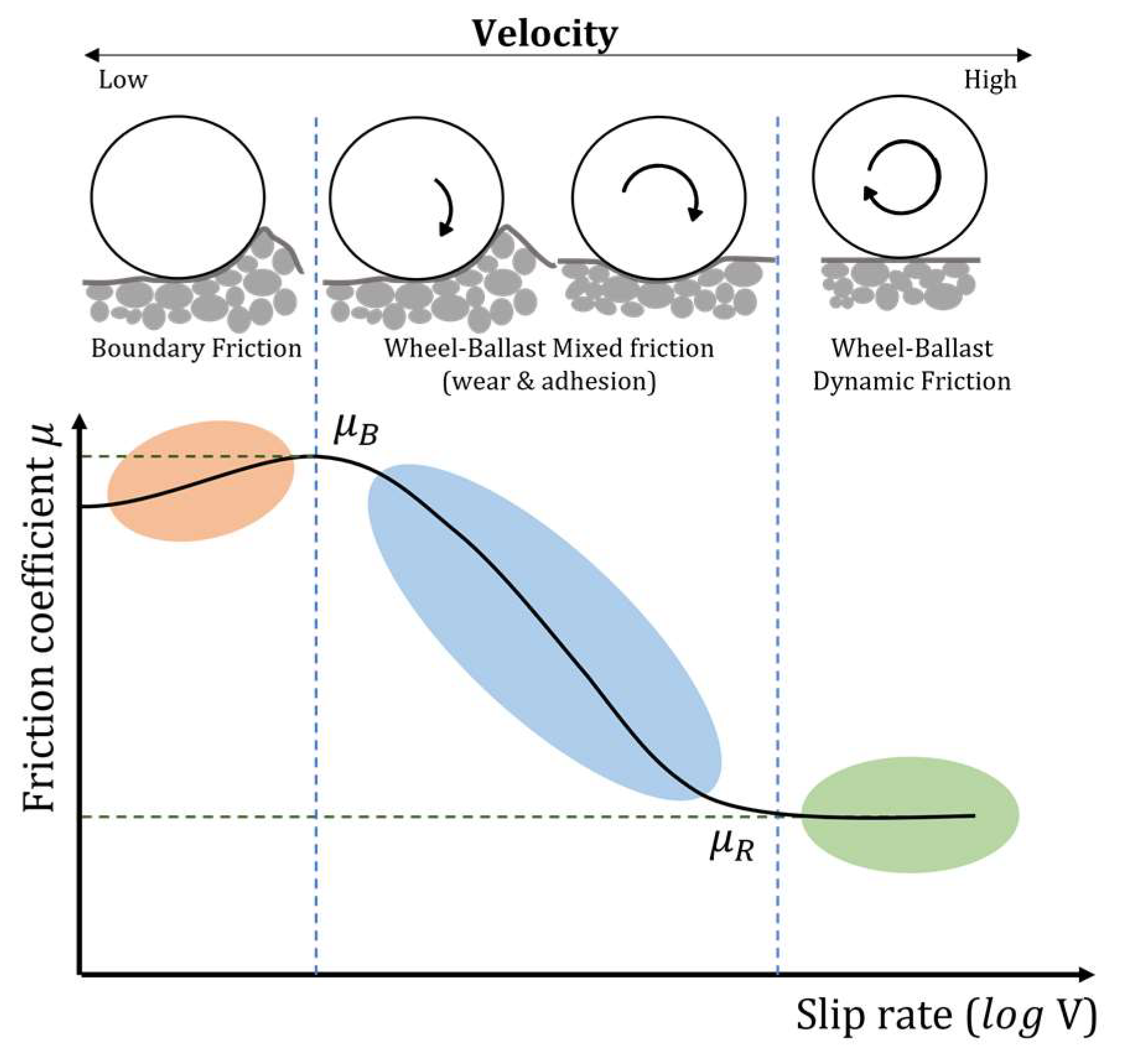
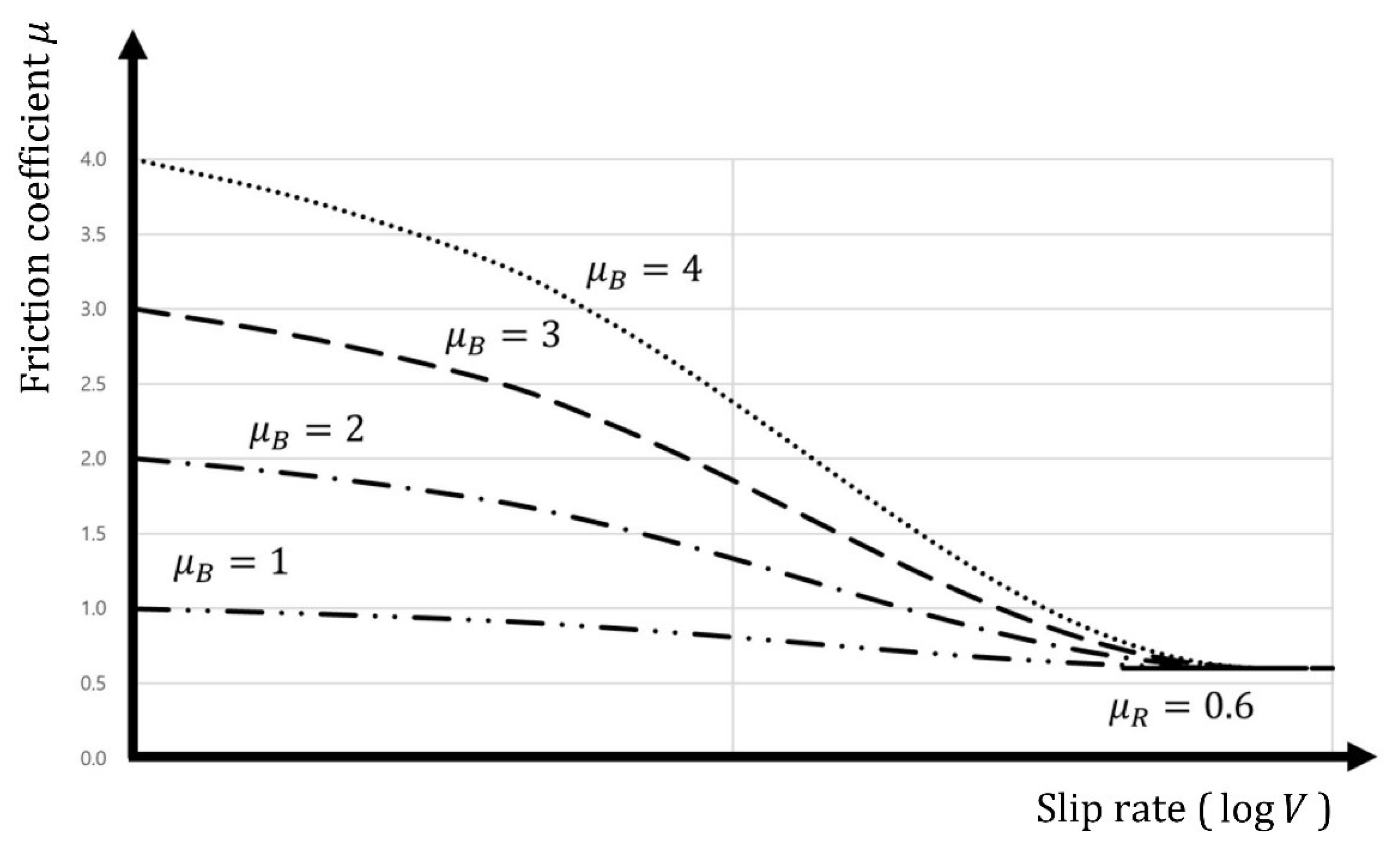
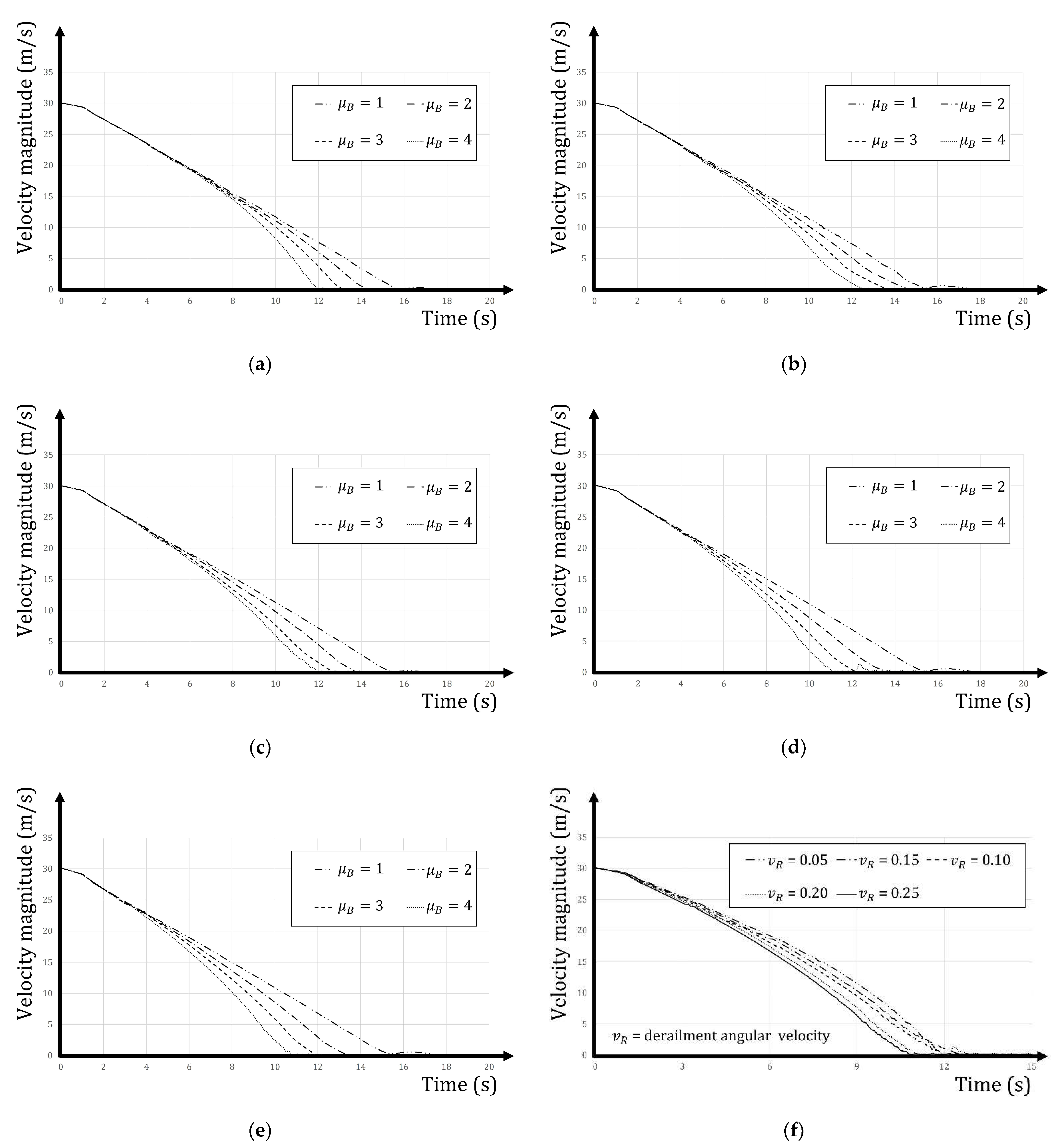
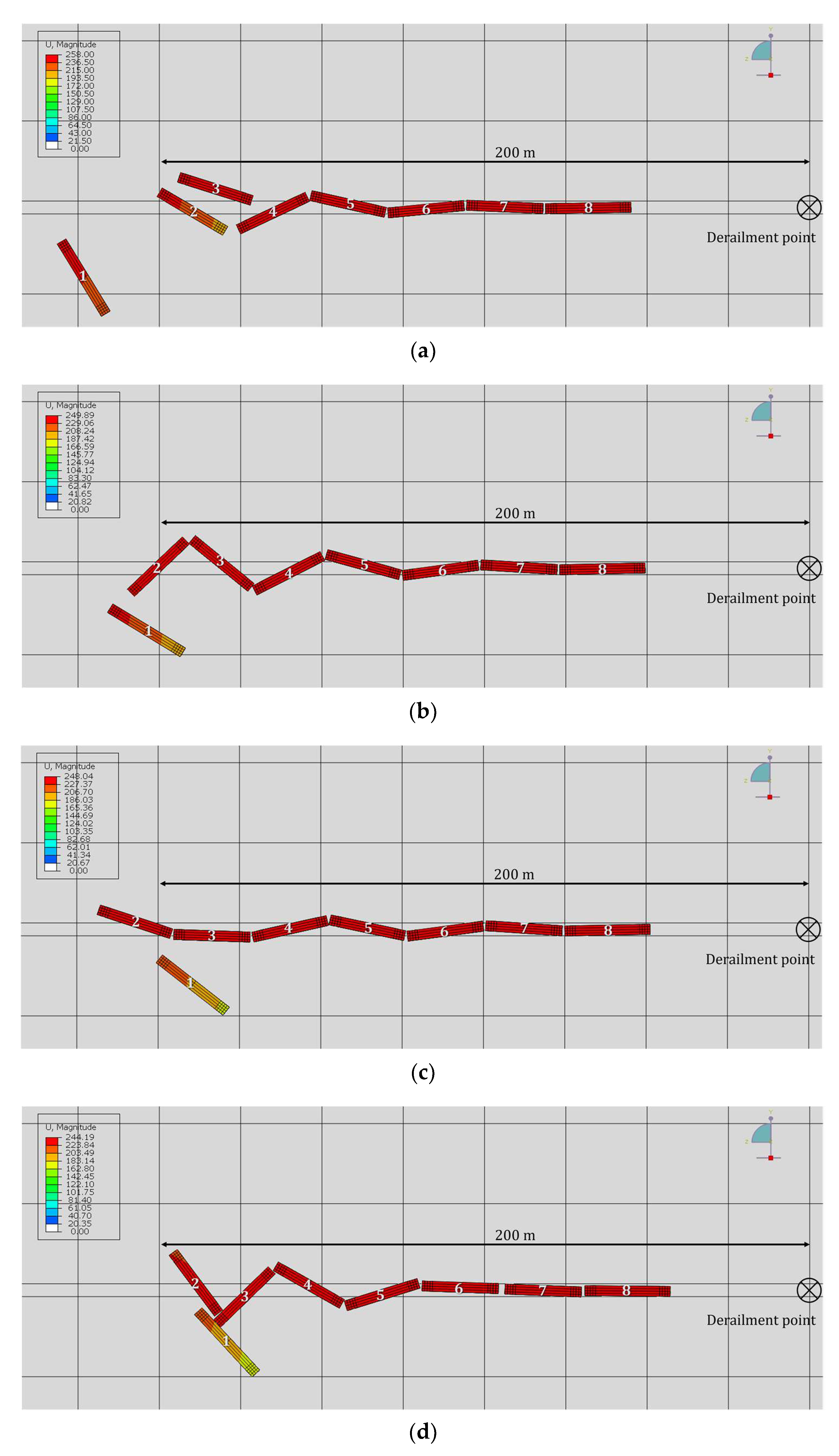
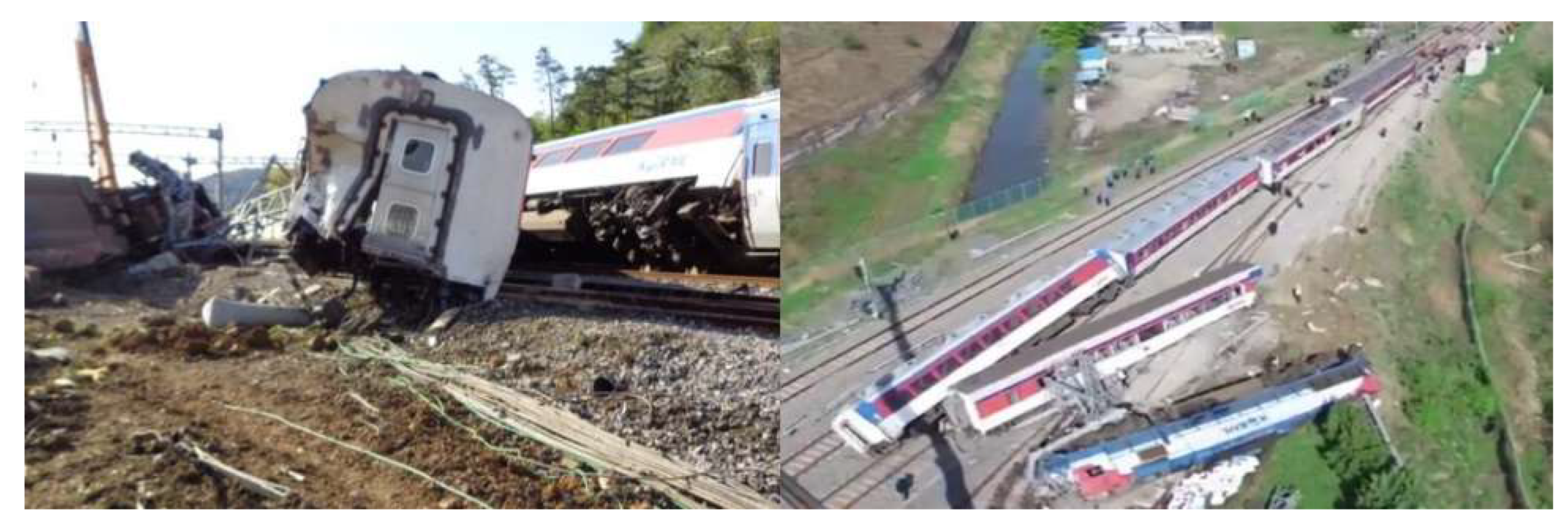


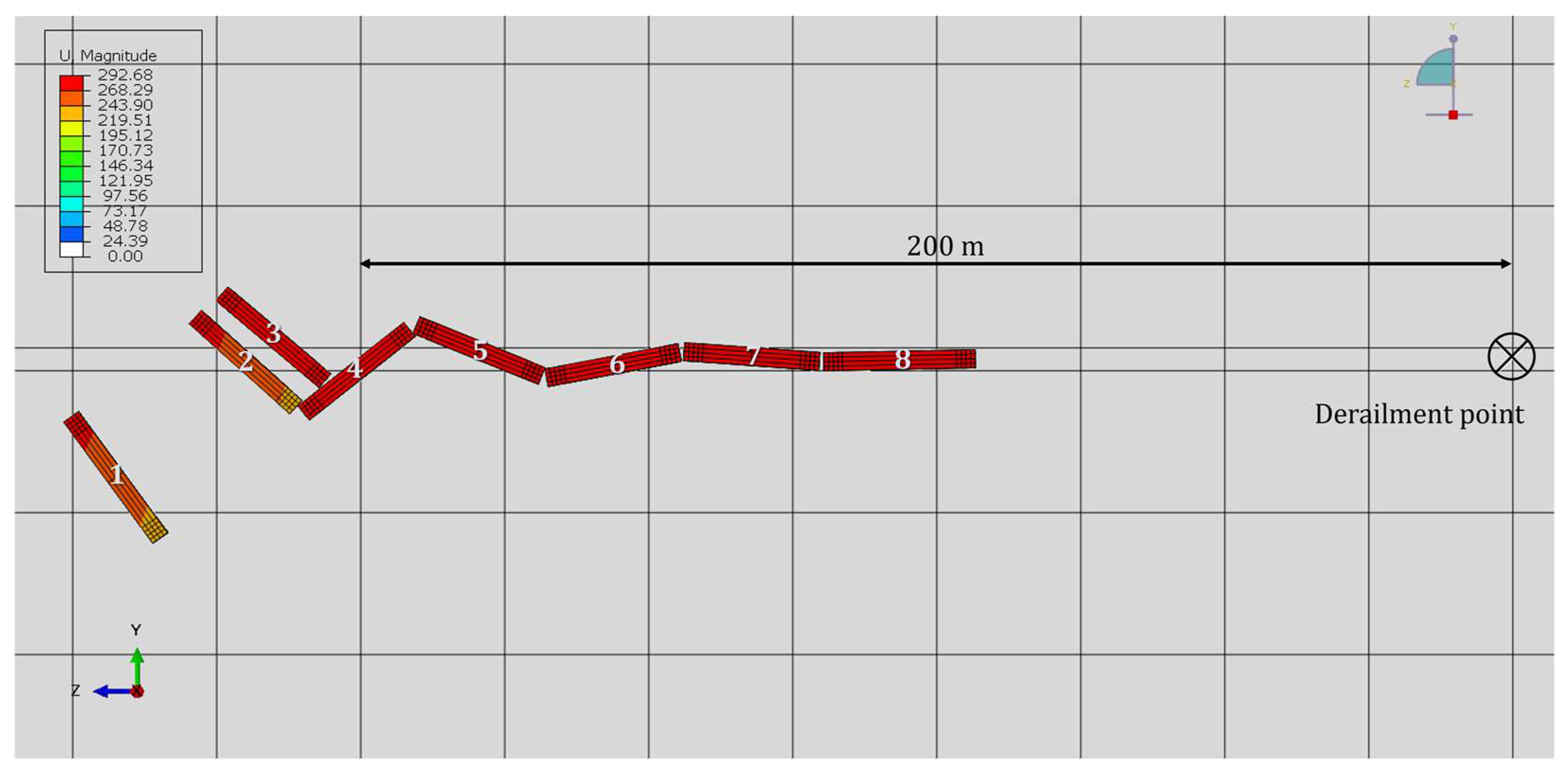
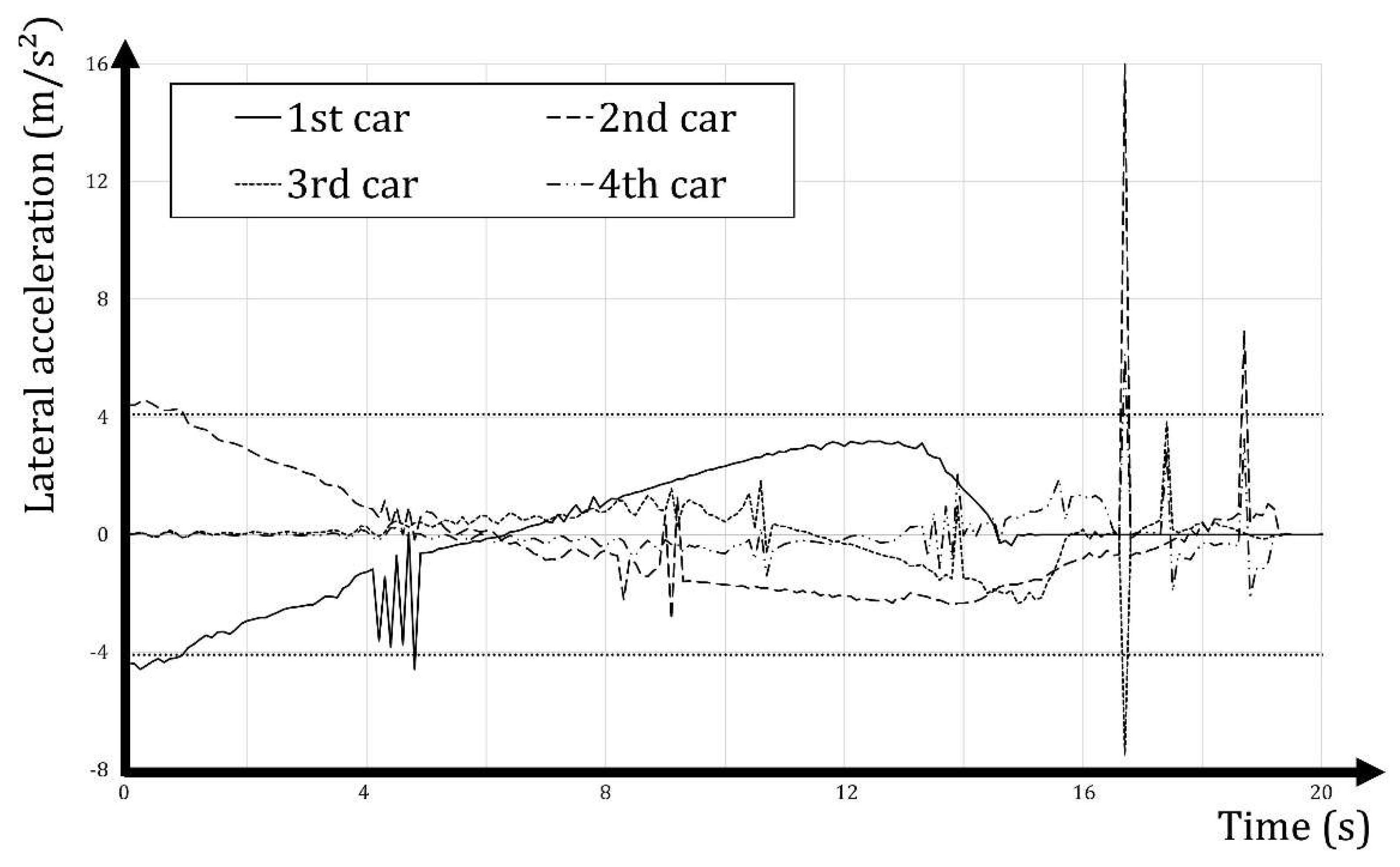
| Accidents | Location/Date | Damage |
|---|---|---|
| Amagasaki derailment | Japan/April 2005 | 107 fatalities, 562 injuries/ Collision with a residential building after derailment |
| Philadelphia derailment | USA/May 2015 | eight fatalities, 59 injuries/ one locomotive and four cars crushed or rolled over |
| Burlington derailment | Canada/February 2012 | One fatality, 44 injuries/one locomotive rolled over and collision with near building after derailment |
| Grayrigg derailment | UK/February 2007 | One fatality, 22 injuries/four cars rolled over |
| Specification | Coupling System | Maximum Speed | Acceleration Ability | |
|---|---|---|---|---|
| EMU-260 | Length: 26.25 m (TC) 23.50 m (M, M’) Width: 3.15 m Height: 4.175 m Weight (1 set): 318 tonne/6 cars | Yield strength: Tensile: 150 kN Compressive: 150 kN Interval Distance: 0.8 m | 286 km/h (Design speed) 260 km/h (Operational speed) | Acceleration: 2.0 km/h/s Deceleration: 4.0 km/h/s (at the time of prototype production) |
| EMU-320 | Length: 26.25 m (TC) 23.50 m (M, M’) Width: 3.15 m Height: 4.175 m Weight (1 set): 465 tonne/8 cars | 352 km/h (Design speed) 320 km/h (Operational speed) |
| Conditions | Temperature (°C) | Friction Coefficient |
|---|---|---|
| Sunshine, dry rail | 19 | 0.6–0.7 |
| Recent rain on the rail | 5 | 0.2–0.3 |
| Grease/damp-leaf-film on the rail | 8 | 0.05–0.1 |
| Yulchon Station Derailment | z-Disp. (m) | Unusual Behaviour after Derailment |
|---|---|---|
| Actual accident | 1st car: ~180 2nd car: ~220 3rd car: ~225 | 1st car: rollover and stop at approximately 180 m 2nd car: yawed over 90° |
| Simulation result | 1st car: 255.53 2nd car: 279.68 3rd car: 278.15 | 1st car: reached the lateral acceleration limit in 4.8 s—140.3 m 2nd car: yawed over 90° and hit the 3rd car |
Disclaimer/Publisher’s Note: The statements, opinions and data contained in all publications are solely those of the individual author(s) and contributor(s) and not of MDPI and/or the editor(s). MDPI and/or the editor(s) disclaim responsibility for any injury to people or property resulting from any ideas, methods, instructions or products referred to in the content. |
© 2023 by the authors. Licensee MDPI, Basel, Switzerland. This article is an open access article distributed under the terms and conditions of the Creative Commons Attribution (CC BY) license (https://creativecommons.org/licenses/by/4.0/).
Share and Cite
Lim, J.; Kong, J. Simplified Dynamic FEA Simulation for Post-Derailment Train-Behaviour Estimation through the Enhanced Input of Wheel–Ballast Friction Interactions. Appl. Sci. 2023, 13, 6499. https://doi.org/10.3390/app13116499
Lim J, Kong J. Simplified Dynamic FEA Simulation for Post-Derailment Train-Behaviour Estimation through the Enhanced Input of Wheel–Ballast Friction Interactions. Applied Sciences. 2023; 13(11):6499. https://doi.org/10.3390/app13116499
Chicago/Turabian StyleLim, Jaehoon, and Jungsik Kong. 2023. "Simplified Dynamic FEA Simulation for Post-Derailment Train-Behaviour Estimation through the Enhanced Input of Wheel–Ballast Friction Interactions" Applied Sciences 13, no. 11: 6499. https://doi.org/10.3390/app13116499




